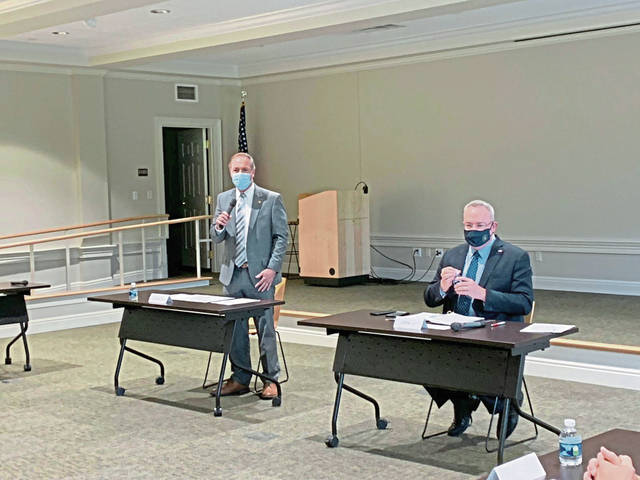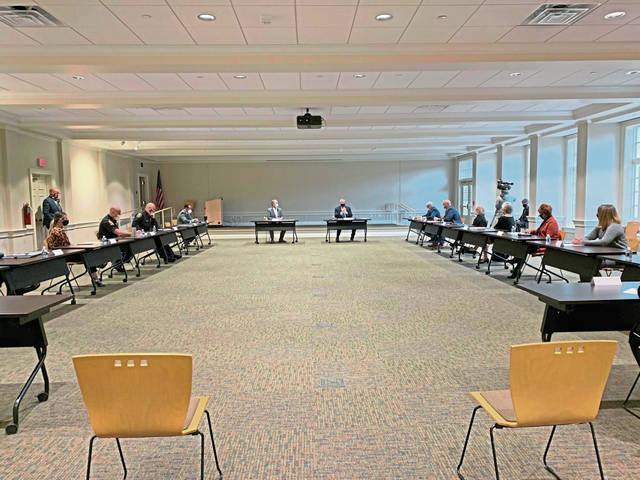National Drug Control Office chief holds roundtable discussion in Ligonier
Westmoreland County has made some strides in introducing programs aimed at helping those with a drug addiction.
Drug treatment court started in 2014. The Westmoreland County Drug Overdose Task Force has enacted a Recovery Friendly Workplace program. Scores of naloxone doses have been handed out by the task force and Westmoreland Drug and Alcohol Commission.
A medication-assisted treatment program is getting started soon at the Westmoreland County Prison, according to Commissioner Sean Kertes.
“It’s baby steps,” he said.
During a roundtable discussion Friday in Ligonier with Jim Carroll, director of the Office of National Drug Control Policy, Kertes asked what more the county can do to expand options for those who need help.
“I wish I had a simple answer,” Carroll responded. “It is groups like this, it is talking about the issue and sitting down as a community to say what can we do here.”
About a dozen Ligonier-area community and state leaders gathered Friday morning at Fort Ligonier to talk about what they’re dealing with regarding drug addiction from a variety of standpoints. Carroll and U.S. Rep. John Joyce, R-Blair County, convened the hourlong event as a way to learn about the issues, discuss potential solutions and share ideas.
Joyce and Carroll commended the participants — all of whom wore masks and sat at desks spaced apart — for their honesty and willingness to discuss the problem that has resulted in about 800 drug overdose deaths in the county from 2015 to Oct. 1, according to coroner statistics.
Westmoreland County was designated in June as a “High Intensity Drug Trafficking Area” by the national office, meaning more funding and information is available to police agencies in an effort to decrease the availability of illicit drugs.
Participants at the roundtable shared concerns and sought guidance on how to better serve those who are in recovery or struggling with addiction. State Sen. Kim Ward, R-Hempfield, said more options are needed for people who are leaving treatment centers, which could be in the form of halfway houses.
“We need to help them further,” she said.
School district officials said they struggle with helping students who are in families where addiction issues are present. Ligonier Valley School District Superintendent Christine Oldham said students in families that live in more rural areas of the district sometimes deal with having an incarcerated parent and less accessibility to addiction treatment or jobs.
“There isn’t always help that’s right there for them,” she said.
The Office of National Drug Control Policy spends about $36 billion annually on treatment, prevention and law enforcement, but that price tag needs to multiply to truly help address the crisis, Carroll said. More money needs to be pushed toward families where addiction is a problem.
“We’re not spending enough money on this issue, but we need to target it correctly,” Carroll said.
He did have a few suggestions for participants and pointed to a Rural Resource Guide, which provides blueprints for programs that have worked in rural areas across the country. One was to create a zone for employers who are willing to hire people in recovery and create tax incentives as a way to help a community develop economically. That could help address stigma while providing supports for those in recovery in a concentrated way.
“Being able to have an economic recovery zone … is one of these little things that might work or at least worth exploring,” Carroll said.
Renatta Signorini is a TribLive reporter covering breaking news, crime, courts and Jeannette. She has been working at the Trib since 2005. She can be reached at rsignorini@triblive.com.
Remove the ads from your TribLIVE reading experience but still support the journalists who create the content with TribLIVE Ad-Free.


